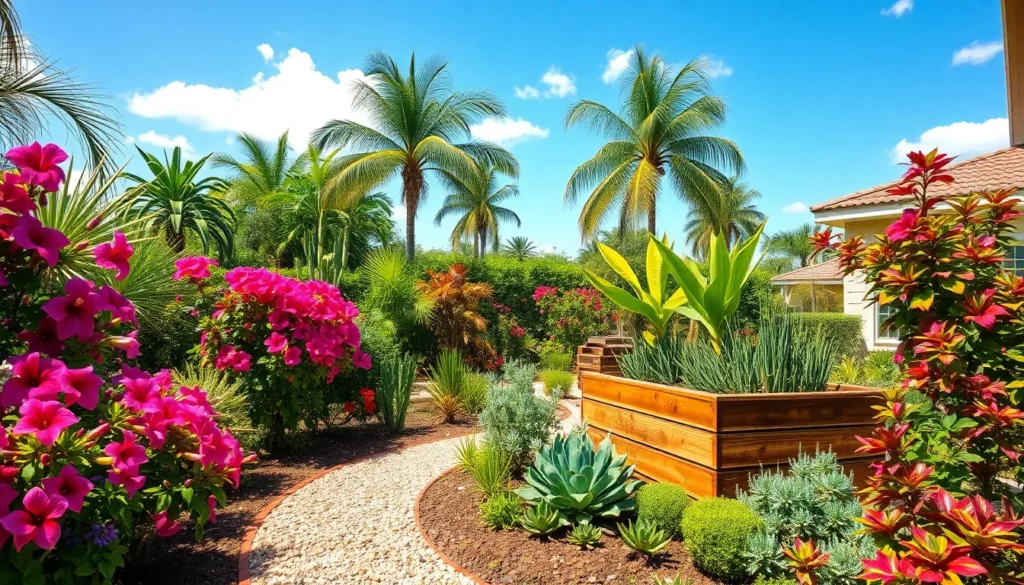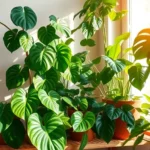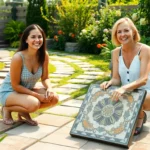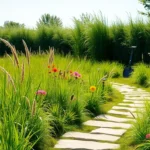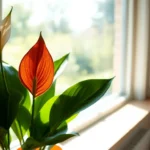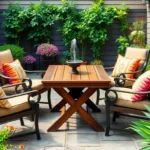Florida’s year-round sunshine opens up incredible possibilities for creating stunning outdoor spaces that thrive in our unique climate. We’ve discovered that gardening in the Sunshine State comes with both amazing opportunities and exact challenges that require smart planning and plant selection.
From tropical palms swaying in coastal breezes to drought-resistant native plants that flourish in our sandy soils, Florida gardening offers endless creative potential. We’ll explore how our state’s diverse microclimates – from humid South Florida to the cooler northern regions – each present distinct advantages for different garden styles.
Whether you’re dreaming of a lush tropical paradise, a low-maintenance xerophytic garden, or a productive vegetable plot that produces year-round harvests, we’ve got the insider knowledge you need. Our comprehensive guide will transform your outdoor space into a thriving Florida garden that not only survives but absolutely flourishes in our distinctive climate conditions.
Create a Tropical Paradise With Native Florida Plants
Building on Florida’s natural climate advantages, we can create stunning tropical landscapes using plants that thrive in our state’s unique conditions. Native and adapted tropical plants require less water, resist local pests, and provide year-round beauty with minimal maintenance.
Choose Heat-Tolerant Palm Varieties
Selecting the right palms forms the backbone of any successful Florida tropical garden. Sabal palms (our state tree) withstand hurricane-force winds and tolerate both drought and flooding conditions. These majestic natives grow 40-60 feet tall and require virtually no maintenance once established.
Coconut palms create instant tropical ambiance in zones 10-11, producing fruit while adding authentic Caribbean flair. Date palms like the Canary Island variety offer feathery fronds and impressive 50-foot heights in central and southern regions. Foxtail palms provide compact elegance for smaller spaces, reaching only 20-30 feet with distinctive bottlebrush-shaped fronds.
Royal palms deliver dramatic vertical impact with their smooth gray trunks and crown shafts reaching 80 feet. We recommend planting these specimens at least 15 feet from structures to accommodate their mature size and root spread.
Incorporate Colorful Bougainvillea and Hibiscus
Bougainvillea transforms any garden space with explosive color displays lasting 8-9 months annually. These drought-tolerant climbers produce papery bracts in vibrant purples, magentas, oranges, and whites while requiring minimal water once established. Training them on trellises, fences, or arbors creates stunning vertical color walls.
Hibiscus varieties offer daily blooms in dinner-plate sizes up to 12 inches across. Native Hibiscus coccineus displays striking red flowers and attracts native butterflies and hummingbirds. Tropical hibiscus provides constant blooms in temperatures above 50°F, with varieties like ‘Red Dragon’ and ‘Yellow Submarine’ offering unique color combinations.
Chinese hibiscus adapts well to container growing, allowing us to move plants indoors during occasional cold snaps. These plants respond excellently to regular feeding and produce 4-6 inch blooms in solid colors or dramatic bi-color patterns.
Add Fragrant Jasmine and Gardenia
Star jasmine creates aromatic ground cover or climbing vines with small white flowers releasing intense evening fragrance. This versatile plant tolerates full sun to partial shade and blooms heaviest during spring and fall months. We can train it over pergolas or let it cascade from hanging baskets for maximum scent distribution.
Gardenia shrubs produce waxy white blooms with intoxicating fragrance from spring through fall. ‘Miami Supreme’ varieties handle Florida’s heat and humidity better than traditional cultivars, maintaining glossy green foliage year-round. These acid-loving plants thrive in well-draining soil with morning sun and afternoon shade protection.
Confederate jasmine (actually a trachelospermum) offers vigorous growth and masses of small fragrant flowers in early spring. This hardy vine tolerates poor soils and drought conditions while providing dense evergreen screening. Night-blooming jasmine releases its strongest fragrance after sunset, making it perfect for planting near patios and bedroom windows.
Design a Low-Maintenance Xerophytic Garden
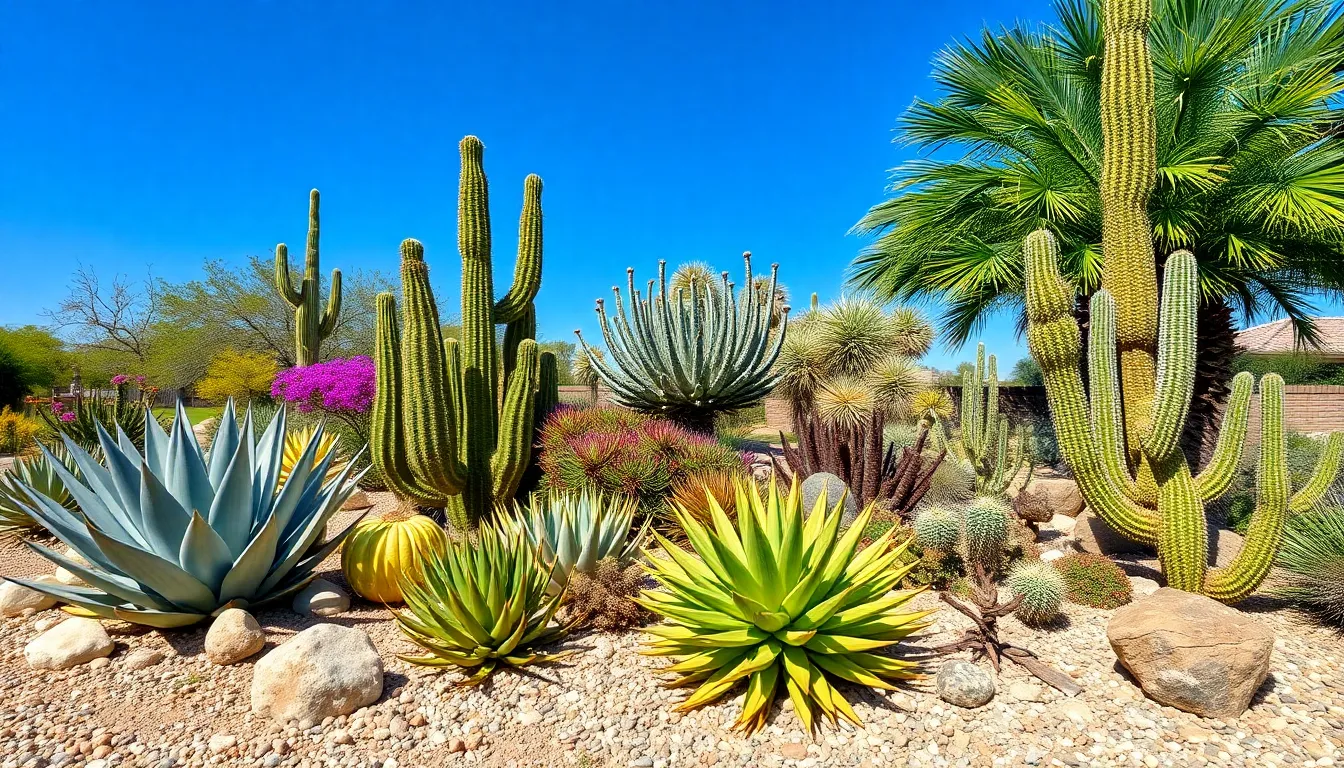
While tropical gardens offer lush beauty, xerophytic gardening provides an equally stunning alternative that requires minimal upkeep and water usage. Xeriscaping techniques combine drought-tolerant plants with strategic design elements to create sustainable landscapes that thrive in Florida’s variable climate conditions.
Select Drought-Resistant Succulents and Cacti
Choose varieties like mangave, agave, and native cacti for optimal Florida adaptation. These xerophytic plants feature thick, fleshy leaves and extensive root systems that naturally store water and withstand extended dry periods. Yucca plants offer architectural interest with their sword-like foliage and occasional dramatic flower spikes.
Plant prickly pear cactus in full sun locations where it’ll flourish with minimal intervention. This native species adapts perfectly to Florida’s sandy, well-drained soils and produces colorful yellow blooms followed by edible fruits. Agave varieties provide sculptural focal points while requiring watering only during establishment periods.
Position these drought-resistant plants in areas that receive 6-8 hours of direct sunlight daily. Their natural heat tolerance makes them ideal candidates for challenging garden spots where other plants might struggle. Once established, most succulents and cacti need supplemental watering only during extended drought periods.
Use Decorative Gravel and Stone Mulching
Apply coquina rock and decorative stones around plant bases to reduce moisture loss and suppress weeds. Stone mulching creates an attractive desert-inspired aesthetic while serving practical functions that significantly reduce maintenance requirements. Gravel mulches allow proper drainage around succulent roots while preventing soil erosion.
Incorporate driftwood and weathered stones to add natural texture and visual interest to xerophytic gardens. These materials complement the architectural forms of cacti and succulents while requiring zero ongoing care. Stone pathways can connect different garden areas while maintaining the low-maintenance theme.
Layer decorative gravel 2-3 inches deep to maximize weed suppression and water conservation benefits. This mulching technique minimizes evaporation from soil surfaces and creates clean, finished appearances around plants. Various stone colors and sizes allow creative design flexibility while serving essential garden functions.
Install Efficient Drip Irrigation Systems
Set up drip irrigation with timers and moisture sensors to deliver targeted watering directly to plant root zones. This efficient system minimizes water waste while promoting healthy plant growth through consistent, controlled moisture delivery. Drip irrigation proves especially valuable during Florida’s unpredictable rainfall patterns.
Configure irrigation zones based on different plant water requirements within your xerophytic garden layout. Newly planted succulents may need more frequent watering during establishment, while mature plants require minimal supplementation. Smart irrigation controllers can adjust schedules automatically based on weather conditions and soil moisture levels.
Install pressure-compensating emitters that provide uniform water distribution regardless of elevation changes or system pressure variations. These components ensure each plant receives appropriate water amounts without manual adjustments. Regular maintenance involves only periodic filter cleaning and seasonal system checks.
Build Raised Garden Beds for Year-Round Growing
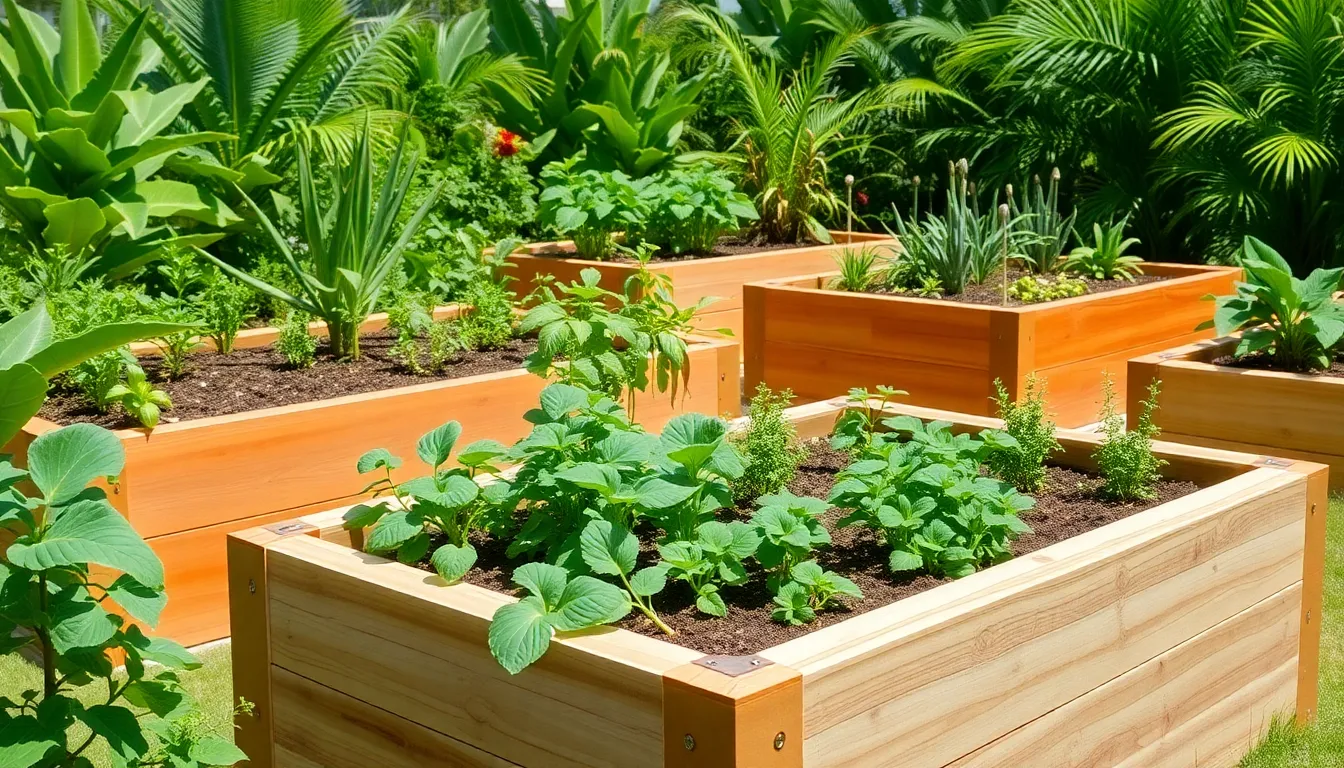
Raised garden beds transform Florida gardening by offering superior control over soil conditions and drainage challenges that plague traditional ground-level planting. We’ll explore how to create durable, productive raised beds that maximize Florida’s year-round growing potential.
Construct Cedar or Composite Material Beds
Cedar stands out as the premium choice for Florida raised beds due to its natural resistance to rot and pests. We recommend cedar planks because they withstand Florida’s humid conditions without chemical treatments that could leach into soil. Composite materials offer another excellent option, providing exceptional durability against weather extremes including intense UV rays and heavy rainfall.
Both materials eliminate the frustration of replacing rotted boards every few years. Cedar’s natural oils repel termites and other wood-boring insects common in Florida, while composite materials won’t warp, crack, or fade under constant sun exposure. We’ve found that these materials maintain structural integrity for decades, making them cost-effective long-term investments for serious gardeners.
Ensure Proper Drainage for Florida’s Rainy Season
Florida’s rainy season brings intense downpours that can waterlog traditional garden beds and suffocate plant roots. We design our raised beds with open bottoms or multiple drainage holes to prevent water accumulation during heavy rainfall periods. This drainage system allows excess water to flow away while retaining optimal soil moisture levels.
Elevating beds 8-12 inches above ground level creates natural drainage while improving soil aeration. We add a layer of coarse gravel or broken pottery at the bottom of beds to enhance water flow and prevent soil from washing away. This drainage strategy becomes critical during Florida’s summer months when afternoon thunderstorms can dump several inches of rain in minutes.
Plan Succession Planting for Continuous Harvests
Succession planting maximizes Florida’s favorable year-round climate by ensuring continuous harvests from the same garden space. We plant new seeds every 2-3 weeks so that as one crop matures and gets harvested, another crop is ready to take its place. This method works exceptionally well with quick-growing vegetables like lettuce, radishes, and green beans.
Florida’s warm temperatures allow for multiple plantings of cool-season crops during winter months and heat-tolerant varieties during summer. We stagger plantings of tomatoes, cucumbers, and peppers to extend harvest periods and avoid overwhelming abundance at once. Raised beds make succession planting easier by providing controlled growing conditions and accessible planting areas for regular seeding schedules.
Establish a Butterfly and Pollinator Garden
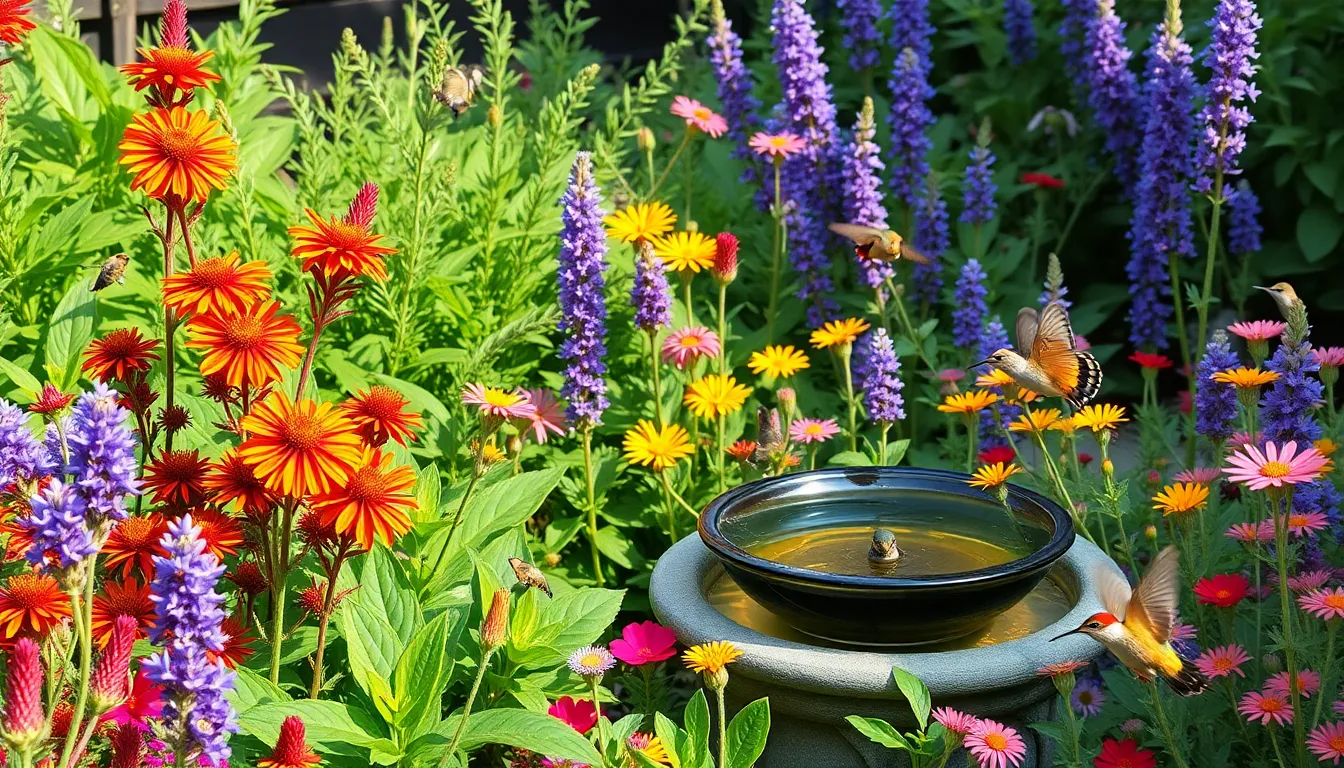
Creating a butterfly and pollinator garden transforms your Florida industry into a vibrant network that supports native wildlife while providing stunning seasonal beauty. This specialized garden approach complements the sustainable gardening principles we’ve explored while focusing specifically on supporting local pollinators.
Plant Native Firebush and Coontie
Firebush (Hamelia patens) serves as a cornerstone plant for Florida pollinator gardens, attracting a diverse array of butterflies, hummingbirds, and beneficial insects with its tubular orange-red flowers. This native shrub blooms continuously from spring through fall, providing consistent nectar sources when other plants may be dormant. We recommend planting firebush in partial to full sun locations where it can reach its mature height of 4-8 feet.
Coontie (Zamia integrifolia) functions as an essential host plant for the endangered Atala butterfly, whose caterpillars depend exclusively on this native cycad for survival. This prehistoric-looking plant adds unique texture to your garden with its glossy, dark green fronds while requiring minimal water once established. Position coontie in shaded to partially shaded areas where it can slowly develop into an attractive 3-foot mound.
Blue Porterweed (Stachytarpheta jamaicensis) completes this native trio by specifically attracting skipper butterflies and other small pollinators with its delicate purple flower spikes. This low-maintenance perennial thrives in Florida’s heat and humidity, blooming year-round in warmer regions of the state.
Create Shallow Water Features for Wildlife
Water sources prove essential for butterfly and pollinator health, providing necessary hydration and thermoregulation during Florida’s intense heat. Design shallow basins or birdbaths with depths no greater than 2 inches to accommodate small pollinators safely. Add flat stones or landing pads within the water feature to give butterflies secure perching spots while they drink.
Fountains or moving water elements prevent mosquito breeding while creating an attractive focal point in your pollinator garden. The gentle sound of trickling water also adds sensory appeal to your outdoor space. Position water features near flowering plants but away from high-traffic areas to minimize disturbance to visiting wildlife.
Muddy puddles serve exact butterfly needs by providing essential minerals through a behavior called “puddling.” Create designated muddy areas by mixing sand, compost, and a small amount of sea salt in shallow depressions near your water source.
Avoid Pesticides to Protect Beneficial Insects
Pesticide-free gardening becomes crucial for maintaining healthy pollinator populations in your butterfly garden, as chemical treatments can eliminate both harmful and beneficial insects indiscriminately. Even organic pesticides can negatively impact butterfly caterpillars and adult pollinators when applied during active feeding periods.
Natural pest control methods protect your garden network while maintaining the delicate balance needed for pollinator success. Encourage beneficial predator insects like ladybugs and lacewings by providing diverse plant structures and avoiding broad-spectrum treatments. Hand-picking larger pests and using targeted organic answers only when absolutely necessary helps preserve the natural food web.
Companion planting strategies reduce pest problems naturally by incorporating plants that repel harmful insects while attracting beneficial ones. Marigolds, basil, and native mint varieties can help deter pests without compromising pollinator safety when planted strategically throughout your butterfly garden.
Design Shade Gardens for Hot Florida Summers
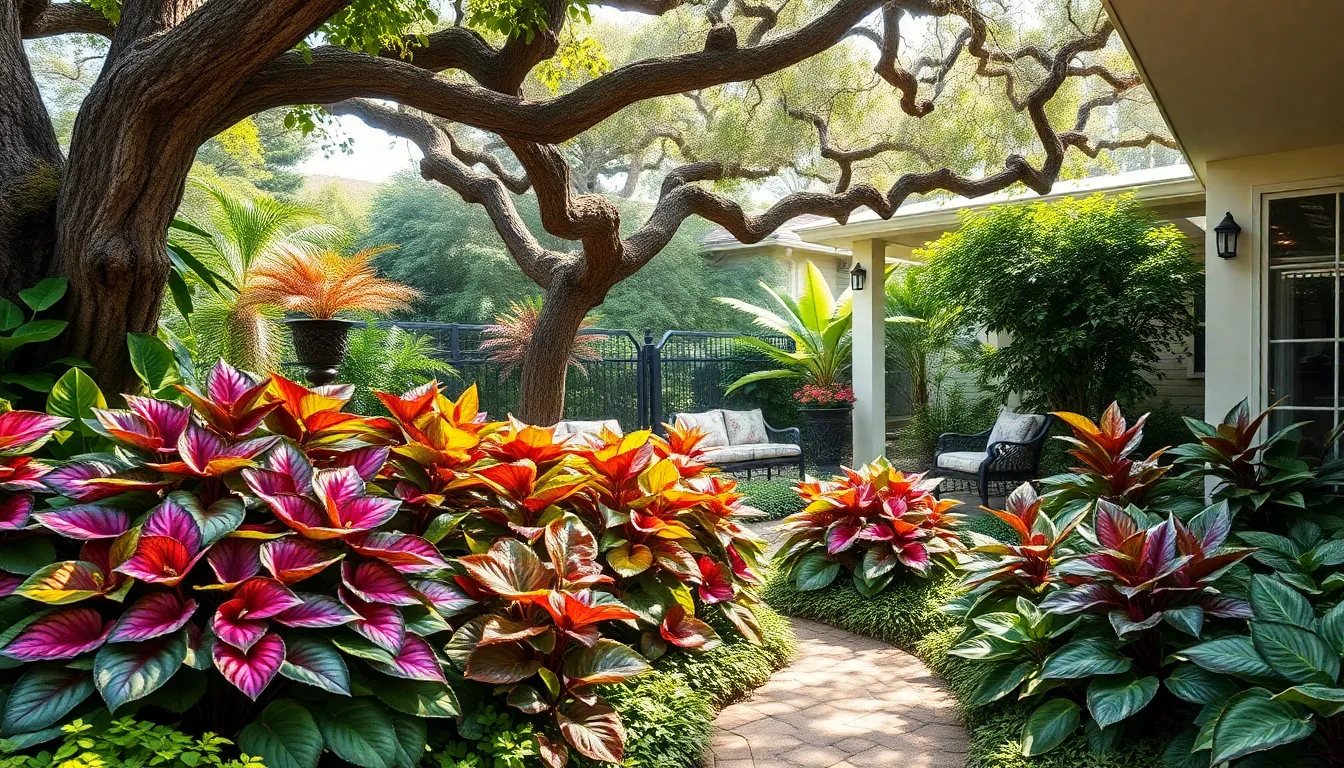
Florida’s intense summer heat makes shaded garden spaces essential for comfortable outdoor living. Creating strategic shade areas allows us to enjoy our gardens even during the hottest months.
Use Caladiums and Coleus for Color
Caladiums bring vibrant foliage displays to our shaded Florida gardens with their heart-shaped leaves in stunning combinations of pink, white, red, and green. These heat-tolerant plants thrive in partial to full shade, making them perfect choices for areas under pergolas or tree canopies where other flowering plants might struggle.
Coleus varieties offer endless color possibilities with their textured leaves ranging from deep burgundy to bright lime green, often featuring contrasting edges or patterns. We can plant these fast-growing annuals in containers or directly in garden beds, where they’ll provide consistent color throughout Florida’s long growing season.
Both plants prefer well-draining soil and regular watering, but they’ll reward us with months of brilliant foliage that brightens even the darkest corners of our shade gardens.
Plant Ferns and Hostas Under Tree Canopies
Sword Ferns create lush, tropical understories beneath our established trees, offering natural Florida charm with their graceful fronds that can reach 2-3 feet in height. These native plants require minimal care once established and help prevent soil erosion while adding year-round green texture to our landscapes.
Hostas complement ferns beautifully with their broad, ribbed leaves that come in various shades of green, blue-green, and variegated patterns. We should plant them in consistently moist areas where they’ll develop into impressive clumps that return larger each year.
Combining these plants creates layered plantings that mimic Florida’s natural forest floors, providing habitat for beneficial insects while requiring less water and maintenance than traditional sun gardens.
Install Misting Systems for Cooling Effects
Misting systems reduce outdoor temperatures by 10-20 degrees, transforming our hot patios and garden areas into comfortable retreats during summer months. These systems work by releasing fine water droplets that evaporate quickly, creating immediate cooling effects without soaking furniture or plants.
We can install these systems along pergola beams, around seating areas, or throughout garden paths where they’ll provide relief during peak heat hours. Modern misting systems include timers and pressure controls, allowing us to customize cooling schedules based on daily temperature patterns.
Strategic placement near our shade gardens creates microclimates that benefit both plants and people, extending the usable hours of our outdoor spaces throughout Florida’s challenging summer season.
Create Edible Landscaping With Tropical Fruits
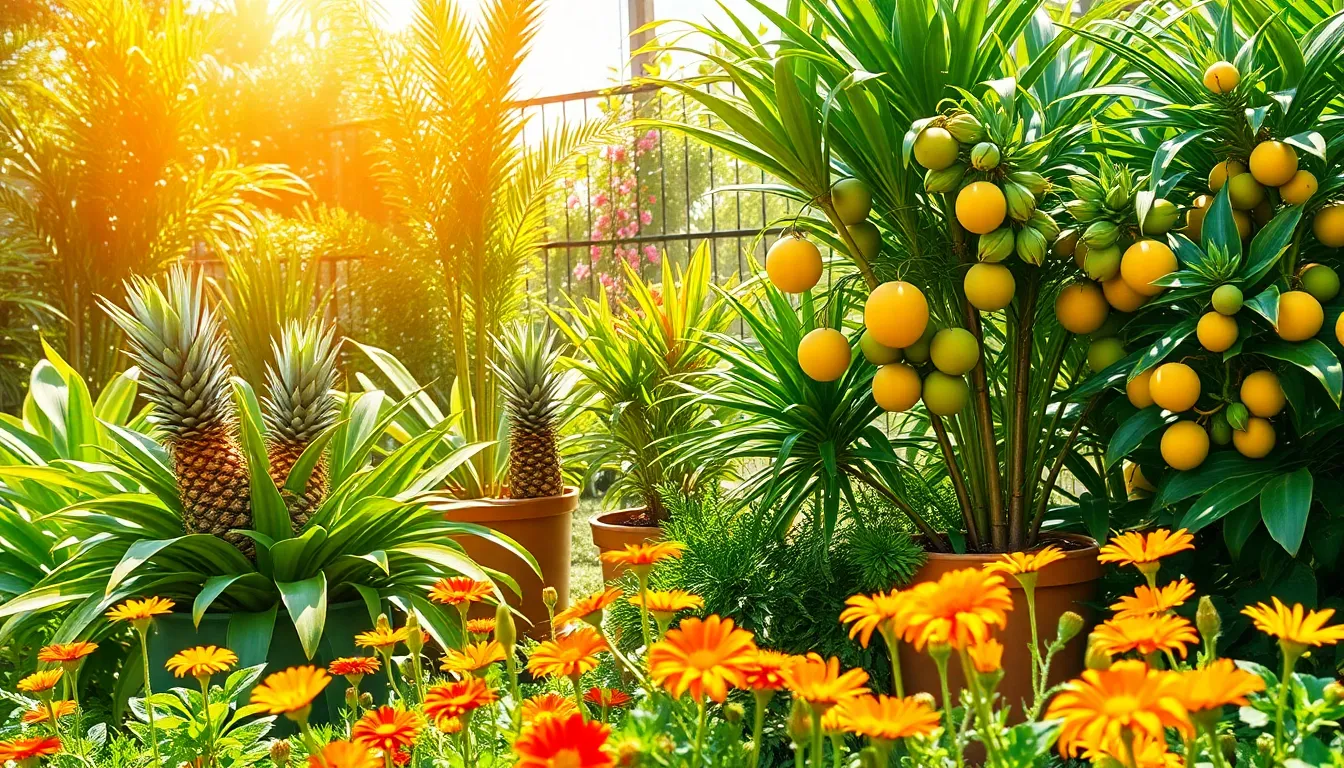
Transform your Florida garden into a productive paradise by incorporating tropical fruits that thrive in our state’s unique climate. We’ll explore versatile options like pineapples that can flourish in both containers and ground plantings, making them perfect for areas with milder winters.
Grow Citrus Trees in Containers or Ground
Citrus trees represent one of the most rewarding additions to any Florida edible industry, offering fresh oranges, lemons, and limes throughout the year. Container growing provides flexibility for northern Florida gardeners who need to protect plants during occasional cold snaps. We recommend choosing dwarf varieties that produce full-sized fruit while maintaining manageable height for easy harvesting.
Ground planting works exceptionally well in central and southern Florida where freezing temperatures rarely occur. Plant citrus trees in well-draining soil with plenty of morning sunlight to maximize fruit production. Space trees at least 12 feet apart to allow for proper air circulation and full canopy development.
Plant Herbs Like Rosemary and Thyme
Perennial herbs like rosemary and thyme offer the perfect combination of culinary value and low maintenance requirements in Florida gardens. These Mediterranean natives adapt beautifully to our climate while providing year-round harvests with minimal water needs. Strategic interplanting with existing industry plants creates natural pest deterrence while maximizing garden space efficiency.
Rosemary thrives in sandy soils and requires little irrigation once established, making it ideal for sustainable Florida gardens. Thyme spreads naturally to form aromatic ground cover that releases fragrance when walked upon. Both herbs follow Florida-Friendly Landscaping principles by reducing water usage and supporting beneficial insects with their small flowers.
Add Edible Flowers Such as Nasturtiums
Nasturtiums bring vibrant color to Florida gardens while providing peppery leaves and flowers for culinary use in salads and garnishes. These annual flowers bloom continuously in cooler months and self-seed readily for future seasons. We suggest planting nasturtiums along garden borders or in containers where their trailing habit creates attractive displays.
Calendula offers another excellent edible flower option with bright orange and yellow petals that add visual appeal to both gardens and dinner plates. These hardy annuals tolerate Florida’s variable weather conditions while producing flowers that can be dried for teas or used fresh in cooking. Plant calendula in fall for winter and spring blooms when temperatures remain moderate for optimal flower production.
Install Water Features for Year-Round Interest
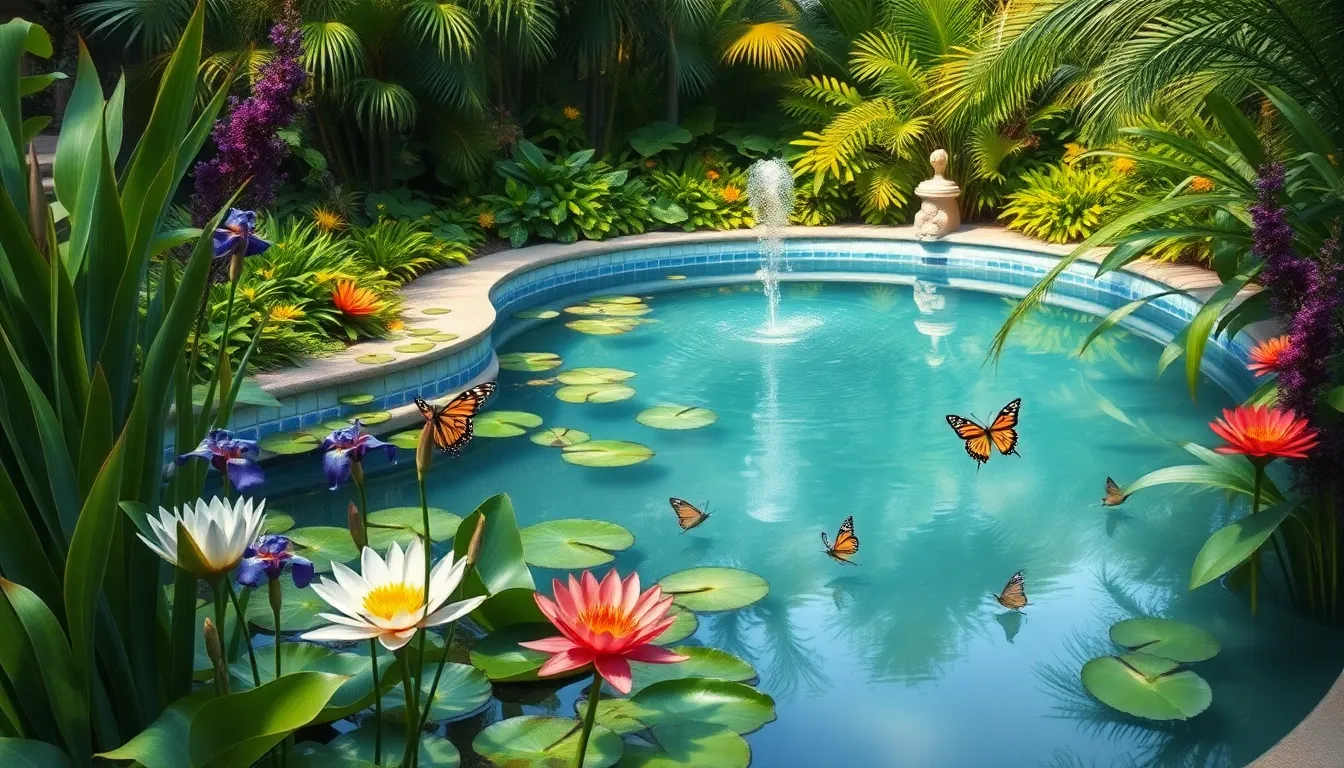
Water features transform Florida gardens into ever-changing landscapes that provide continuous visual appeal and functional benefits throughout the year. They support local wildlife while creating peaceful environments that enhance our outdoor living experience.
Build Natural Swimming Pools With Plants
Natural swimming pools offer a sustainable alternative to traditional chlorinated pools by using plants to filter and clean the water naturally. We can design these eco-friendly features to integrate seamlessly with Florida’s tropical industry, creating a unique focal point that requires fewer chemicals and less maintenance. Plants like water lilies, cattails, and submerged oxygenators work together to maintain water quality while providing habitat for beneficial wildlife. These living pools blend perfectly with our state’s natural environment, offering both recreation and environmental benefits that conventional pools simply can’t match.
Create Rain Gardens for Stormwater Management
Rain gardens serve as shallow depressions that collect and filter rainwater runoff, addressing Florida’s frequent heavy rainfall and stormwater management challenges. We plant these functional landscapes with native species like blue flag iris, firebush, and swamp sunflower to support local biodiversity while improving water quality. These strategic plantings help prevent erosion and reduce flooding around our homes during Florida’s intense summer storms. Native plants in rain gardens require minimal maintenance once established, making them both environmentally responsible and cost effective answers for managing excess water.
Add Fountains or Ponds for Relaxation
Fountains and ponds create soothing soundscapes that mask traffic noise while providing visual interest throughout Florida’s year round growing season. We can incorporate aquatic plants like water hyacinth and pickerel rush to enhance these features naturally, attracting birds and butterflies to our gardens. Small recirculating fountains work particularly well in Florida’s climate, providing consistent water movement that prevents mosquito breeding while creating cooling effects during hot summer months. These water features blend seamlessly with tropical plantings, offering peaceful retreats where we can unwind after long days in our bustling state.
Plan Seasonal Color Rotations
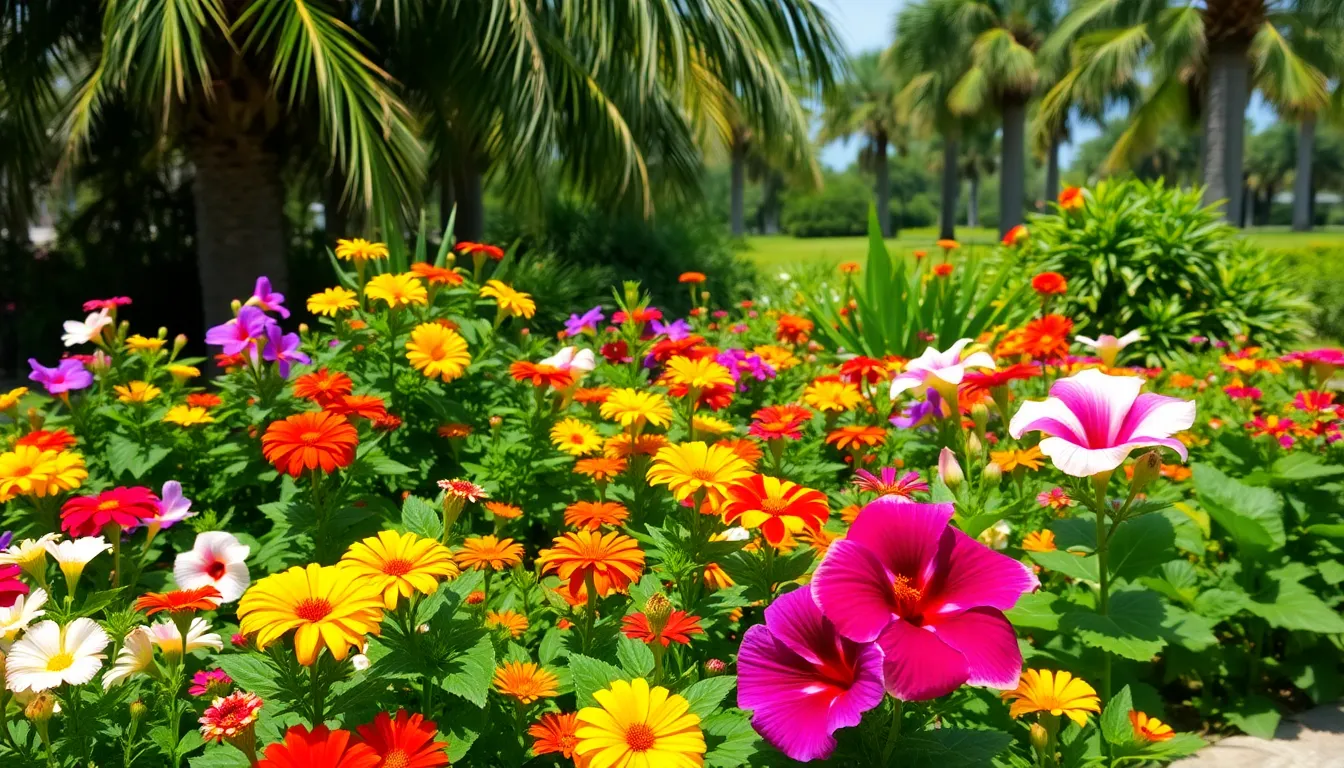
Florida’s year-round growing season allows us to maintain continuous color through strategic plant timing. We can create vibrant displays by rotating different plant types based on their optimal growing seasons.
Use Annuals for Spring and Fall Displays
Petunias flourish during Florida’s mild spring and fall seasons, providing cascades of colorful blooms in purple, pink, white, and yellow varieties. These fast-growing plants establish quickly and produce abundant flowers when temperatures range between 60-75°F.
Marigolds offer reliable color throughout spring and fall months, with their bright orange and yellow blooms lasting up to 4 months per planting cycle. French marigolds and African marigolds both perform exceptionally well in Florida’s transitional seasons.
Zinnias create stunning displays from March through May and September through November, producing bold flowers in red, orange, pink, and coral shades. State of the Art and Profusion series varieties show excellent heat tolerance and disease resistance.
Impatiens work perfectly for shaded spring and fall areas, blooming continuously in white, pink, red, and purple colors. New Guinea impatiens handle more sun exposure than traditional varieties while maintaining their vibrant flower production.
Plant Perennials for Long-Term Structure
Bird of Paradise establishes permanent focal points with exotic orange and blue flowers that resemble tropical birds in flight. These perennials reach 4-6 feet tall and bloom repeatedly throughout the year once established.
Azaleas provide spectacular early spring color displays with masses of pink, white, red, or purple blooms covering entire shrubs. Encore azaleas offer additional fall flowering periods, extending the blooming season significantly.
Hibiscus delivers large, showy flowers year-round in tropical colors including red, pink, yellow, and orange varieties. Both hardy hibiscus and tropical hibiscus species thrive in Florida gardens with minimal maintenance requirements.
Lantana creates continuous blooms in yellow, orange, red, and purple combinations while attracting butterflies and hummingbirds. This drought-tolerant perennial spreads naturally to fill garden spaces with colorful flower clusters.
Schedule Bulb Plantings for Winter Blooms
Amaryllis bulbs planted in October and November produce spectacular winter flowers with large, trumpet-shaped blooms in red, pink, white, and striped varieties. These bulbs typically flower 6-8 weeks after planting and can be replanted annually.
Rain lilies bloom throughout winter months when planted in early fall, producing delicate pink, white, or yellow flowers after rainfall events. These native Florida bulbs naturalize easily and require no special care once established.
Gladiolus bulbs planted in December create tall flower spikes with colorful blooms in spring, featuring red, pink, purple, yellow, and white varieties. Stagger plantings every 2 weeks for extended flowering periods.
Caladium bulbs started indoors in January provide colorful foliage for shaded winter areas, displaying heart-shaped leaves in pink, red, white, and green patterns. These heat-loving plants transition beautifully into summer gardens after the last frost.
Incorporate Vertical Growing Solutions
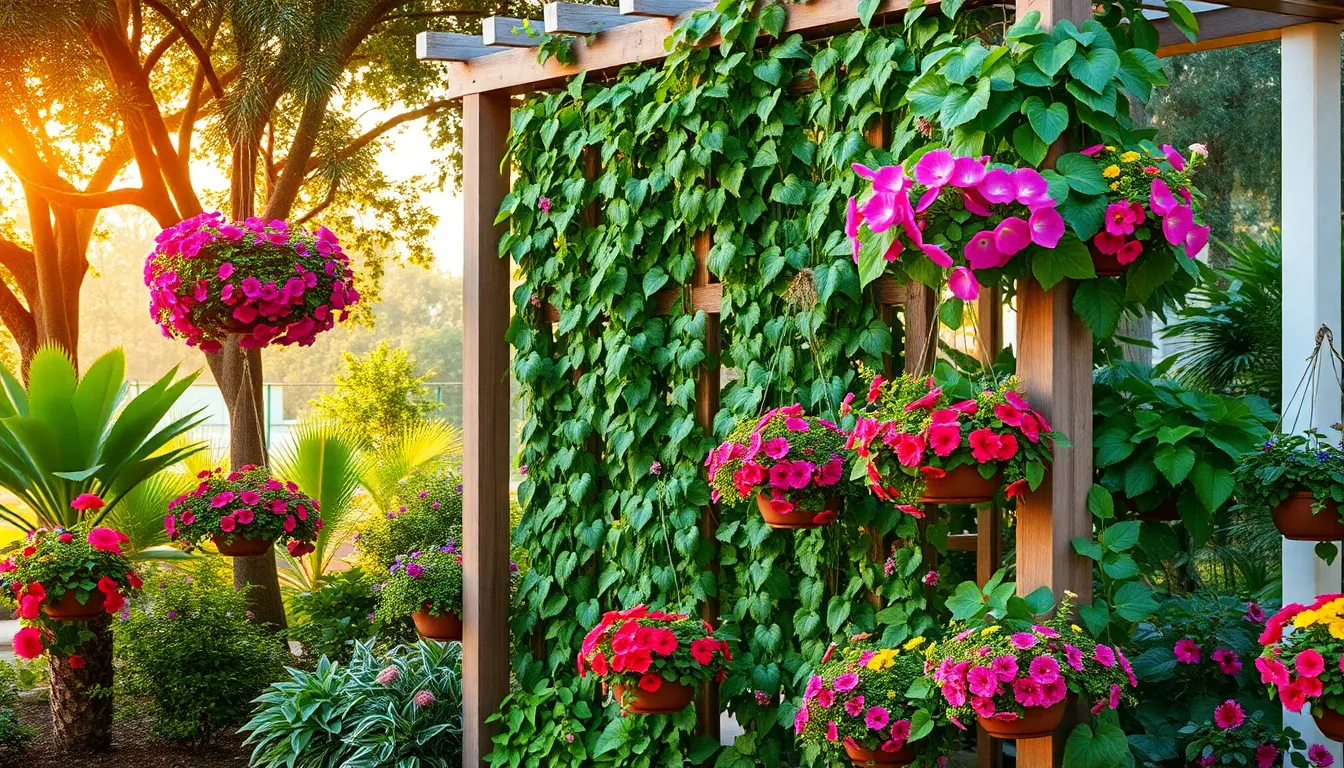
Vertical growing transforms small Florida gardens into lush, productive spaces that maximize every square foot. These answers work particularly well in our state’s subtropical climate where plants grow vigorously year-round.
Install Trellises for Climbing Vines
Trellises provide essential support for climbing plants that thrive in Florida’s warm, humid conditions. English Ivy and Pothos excel on these structures, creating natural green screens that reduce cooling costs during our intense summer months. Bamboo stakes offer an attractive, sustainable option for constructing trellises that complement tropical garden aesthetics.
Design your trellis system to handle Florida’s occasional strong winds and heavy rainfall. Materials like cedar or powder-coated metal resist our humid climate better than untreated wood options. Position trellises against walls or fences to create living barriers that add privacy while filtering harsh afternoon sun.
Select climbing vines based on your exact microclimate and sun exposure needs. Morning glory and passion vine produce stunning flowers that attract pollinators, while edible options like dragon fruit or passion fruit provide both beauty and harvest opportunities.
Create Living Walls With Air Plants
Air plants (Tillandsia) represent perfect candidates for Florida living walls since they naturally thrive in our humid environment without requiring soil. These epiphytes attach directly to walls using wire mounts or specialized brackets, creating stunning vertical displays that require minimal maintenance. Our state’s natural humidity levels provide the moisture these plants need to flourish.
Install living walls in areas with good air circulation to prevent fungal issues common in Florida’s climate. Morning sun exposure works best for most air plant varieties, protecting them from our intense afternoon heat while providing adequate light for photosynthesis.
Group different Tillandsia species together for varied textures and colors throughout the year. Spanish moss, ball moss, and pink quill create ever-changing combinations that change seasonally, adding visual interest to patios, screened porches, and covered outdoor areas.
Use Hanging Baskets for Small Spaces
Hanging baskets maximize growing space on balconies, patios, and small courtyards where ground space is limited. Ferns and flowering plants perform exceptionally well in hanging containers, especially when positioned to receive filtered morning light and protection from Florida’s harsh afternoon sun.
Choose plants that prefer partial shade and require minimal maintenance for the best results in hanging basket systems. Boston ferns, staghorn ferns, and flowering vines like calibrachoa create beautiful cascading displays that soften hard architectural lines.
Position hanging baskets at varying heights to create layered visual interest while ensuring adequate air circulation between containers. This arrangement prevents fungal problems that can develop in Florida’s humid conditions while making watering and maintenance more manageable throughout our growing season.
Design Outdoor Living Spaces Within Gardens
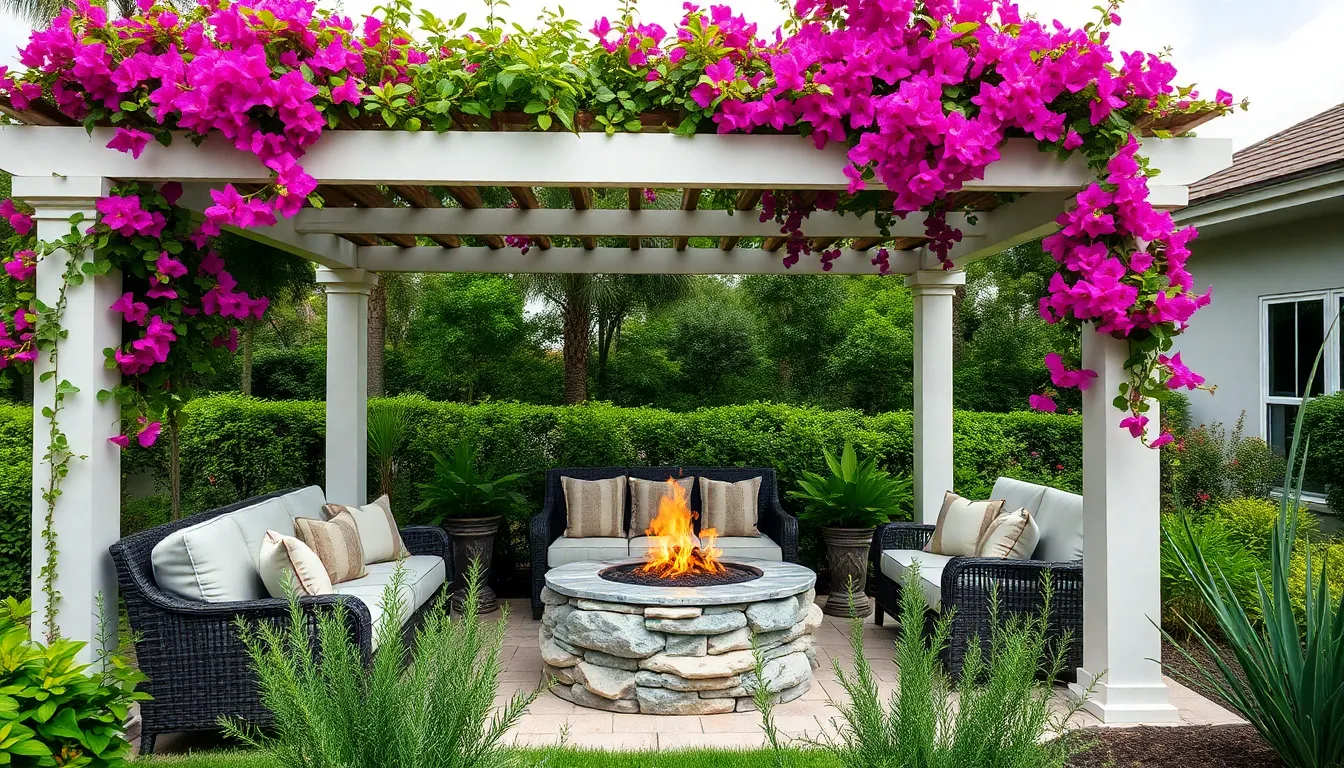
Transforming your Florida garden into a functional outdoor living space extends your home’s usable area while taking advantage of the state’s favorable year-round climate. We’ll explore strategic design elements that create comfortable, practical spaces for relaxation and entertainment.
Create Shaded Seating Areas With Pergolas
Pergolas provide essential relief from Florida’s intense sunshine while maintaining an open, airy atmosphere in your garden. We recommend positioning these structures to maximize shade during peak sun hours while preserving scenic views of your industry.
Installing pavers around pergola seating areas creates cool, comfortable flooring that remains pleasant underfoot even during hot summer days. These hardscape surfaces drain quickly after Florida’s frequent afternoon showers, allowing you to return to outdoor relaxation sooner.
Climbing plants on pergola frames enhance both shade coverage and visual appeal throughout the seasons. Bougainvillea, confederate jasmine, and passion vine thrive on these structures, creating natural canopies that filter harsh sunlight while adding fragrant blooms to your outdoor living space.
Install Outdoor Kitchens Among Herb Gardens
Outdoor kitchens positioned within herb gardens provide immediate access to fresh seasonings while creating functional cooking spaces that extend your home’s entertainment capabilities. We suggest designing kitchen layouts that allow easy movement between cooking areas and herb plantings.
Grills, countertops, and ample storage transform garden spaces into complete outdoor culinary centers that rival indoor kitchens. Weather resistant materials like stainless steel and natural stone withstand Florida’s humidity and temperature fluctuations while maintaining their appearance over time.
Fresh herbs planted within arm’s reach of cooking surfaces include heat loving varieties like rosemary, thyme, and oregano that flourish in Florida’s climate. These perennial plants provide continuous harvests while requiring minimal maintenance once established in your outdoor kitchen garden.
Add Fire Features for Cool Winter Evenings
Fire pits and chimineas create warm gathering spaces that extend outdoor living seasons during Florida’s cooler winter months. We position these features away from overhanging branches and in areas that encourage conversation without obstructing garden pathways.
Strategic seating arrangements around fire features maximize warmth distribution while creating intimate spaces for socializing. Stone or concrete seating walls double as planters for cold hardy plants that provide winter interest around your fire area.
Safety considerations include maintaining adequate clearance from structures and selecting fire resistant materials for surrounding hardscapes. Natural gas connections provide consistent, controllable flames, while wood burning options create traditional campfire ambiance that many Florida residents enjoy during brief cool spells.
Conclusion
Florida’s diverse climate zones offer endless possibilities for creating stunning outdoor spaces that reflect your personal style and gardening goals. Whether you’re drawn to lush tropical paradises or prefer water-wise xerophytic designs we’ve shown you practical ways to maximize your garden’s potential year-round.
The key to success lies in understanding your local microclimate and selecting plants that naturally thrive in your exact conditions. From vertical growing answers to functional outdoor living spaces these strategies help you create gardens that are both beautiful and sustainable.
We encourage you to start with one or two concepts that excite you most then gradually expand your outdoor oasis. With Florida’s favorable growing conditions and the right approach your garden can become a true extension of your home that brings joy throughout every season.
Frequently Asked Questions
What makes Florida’s climate unique for gardening?
Florida’s year-round sunny weather and diverse microclimates create exceptional gardening opportunities. The state ranges from humid tropical conditions in South Florida to cooler northern areas, allowing for various garden styles. This climate diversity enables gardeners to grow tropical plants, drought-tolerant species, and productive vegetables throughout the year with proper plant selection.
Which palm trees work best in Florida gardens?
Heat-tolerant palm varieties like Sabal palms, coconut palms, and royal palms are ideal for Florida conditions. These species are naturally adapted to the state’s climate, requiring less maintenance while providing classic tropical aesthetics. They resist local pests and can withstand Florida’s weather patterns, making them reliable choices for long-term landscaping.
How do I create a low-maintenance garden in Florida?
Focus on xerophytic gardening with drought-tolerant plants like mangave, agave, and native prickly pear. Use decorative gravel and stone mulching to reduce moisture loss and suppress weeds. Install efficient drip irrigation systems for targeted watering, which minimizes water waste while ensuring plants receive adequate hydration during unpredictable rainfall patterns.
What are the best plants for vertical growing in Florida?
English Ivy and Pothos thrive in Florida’s warm, humid conditions and work excellently for vertical trellises. For living walls, use air plants (Tillandsia species) that require minimal maintenance and love humidity. Choose materials that can withstand strong winds and heavy rainfall, and select plants based on your specific microclimate conditions.
Why should I use raised garden beds in Florida?
Raised beds provide superior control over soil conditions and solve drainage challenges common in Florida’s ground-level planting. Use cedar or composite materials for durability against rot and pests. Proper drainage prevents waterlogging during rainy seasons, and raised beds allow for succession planting to maximize continuous harvests year-round.
How can I attract pollinators to my Florida garden?
Plant native species like firebush, coontie, and blue porterweed to attract butterflies and other pollinators. Include shallow water features for hydration and avoid pesticides that harm beneficial insects. Use natural pest control methods and companion planting strategies to maintain a healthy ecosystem that supports local wildlife while enhancing your garden’s beauty.
What plants work well in Florida’s shaded areas?
Caladiums and Coleus provide vibrant foliage in shaded spots, while ferns and hostas create lush, layered plantings under tree canopies. These plants mimic natural forest floors and thrive in Florida’s filtered light conditions. Consider installing misting systems to cool these areas during intense summer heat, making them more comfortable and plant-friendly.
Can I grow edible plants in my Florida garden?
Absolutely! Tropical fruits like pineapples and citrus trees thrive in Florida’s climate. Grow dwarf citrus varieties in containers for flexibility. Plant perennial herbs such as rosemary and thyme for low-maintenance culinary options. Add edible flowers like nasturtiums and calendula for color and flavor while maintaining resilience in variable weather conditions.
How do I maintain year-round color in my Florida garden?
Plan seasonal rotations using annuals like petunias, marigolds, and zinnias for spring and fall displays. Include perennials such as Bird of Paradise, azaleas, and hibiscus for long-term structure. Schedule bulb plantings with amaryllis, rain lilies, and gladiolus for winter blooms, ensuring continuous vibrancy throughout all seasons.
What water features work best in Florida gardens?
Consider natural swimming pools with plant filtration, rain gardens for stormwater management, and fountains or ponds for relaxation. These features provide visual appeal, support local wildlife, and address environmental concerns. Water features are particularly valuable in Florida’s climate, offering cooling effects and creating focal points that enhance the overall garden experience.

